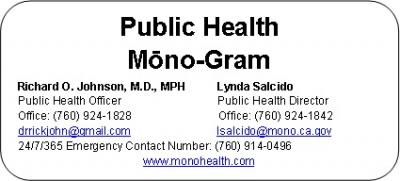Mono-Gram - E-Cigarettes: An E-Normous Problem 1/29/2015
In a September, 2014, the Mono County Health Department surveyed 19 markets in unincorporated Mono County. 17 (89%) sold tobacco, and only 3 stores sold e-cigarettes. In Mammoth Lakes, 9 out of 12 stores sold tobacco and 4 sold e-cigarettes. However, recent trends are troubling: The percent of stores selling electronic cigarettes rose from 21% to 39%, an increase of 18% over the past year. The percent of stores selling flavored tobacco products also increased from 48% to 58%.
In all stores, e-cigarettes were the least sold of tobacco-related products. “I looked into electronic cigarettes; it is an expensive endeavor to get in to,” stated a Mammoth store owner. Another reported, “Kids have come in asking for ‘vapes’ [E-cigarettes].”
Flavors offered make e-cigarettes attractive to kids. A University of California San Diego study showed there were 288 e-cigarette brands available online in 2012. By January 2014, there were 466 brands with 7764 unique flavors, such as bubble gum, Captain Crunch, gummy bear and cotton candy. The top e-cigarette brands are owned by tobacco companies. Their products are promoted through TV ads and other media popular with young people.
While some e-cigarette manufacturers claim e-cigarettes emit a “harmless water vapor,” e-cigarettes emit small particles that can hurt the lungs of the user and those nearby. Essentially, they are an electronic delivery system for nicotine – a ticket to nicotine addiction and death. California experienced a five-fold increase in the number of calls to poison control centers involving e-cigarette liquid exposures in children aged five and under between 2012 and 2013. At this point, e-cigarette products are completely unregulated, causing a considerable variation in the product and its liquid; many of the products are made in China.
Local regulation does not deal with the product, but deals with access and exposure. A California state law prohibits sales to minors. A 2014 Mammoth Lakes ordinance includes electronic cigarettes in the Town ‘No Smoking’ policy. Other businesses, such as Mammoth Mountain and Mammoth Hospital, Mammoth Lakes Housing and IMACA low income housing also include electronic cigarettes in their smoke free policies.
A bill just introduced into the California legislature would add e-cigarettes to the list of tobacco products regulated in the state, which already forbids smoking in workplaces, restaurants, bars and other places. It would also ramp up penalties for selling e-cigarettes, which come in such flavors as bubble gum and chocolate, to minors. California would be the fourth U.S. state to treat them like regular cigarettes, and the 23rd to regulate e-cigarettes in some way. In California, the most populous U.S. state, 122 cities and counties have banned the use of e-cigarettes in certain public places.
E-cigarette proponents claim they help people quit regular cigarettes. However, research shows that smokers begin to use both regular cigarettes and e-cigarettes. If e-cigarettes are really meant to help people stop smoking, why are they being marketed to our kids who are not smoking – yet?
To quit with the help of medication, the California Department of Public Health recommends that existing over-the-county nicotine replacement products be used. Their Smoker’s Helpline quit tobacco counseling can be accessed at 800-NO-BUTTS.


